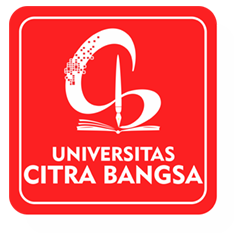PENGARUH PENGGUNAAN MEDIA AUDIO-VISUAL TIPE SOUND-SLIDE TERHADAP MINAT BELAJAR SISWA KELAS III PADA MATA PELAJARAN IPS DI SEKOLAH DASAR INPRES BERTINGKAT OEBOBO 2 KOTA KUPANG
Keywords:
Media Audio-Visual, tipe Sound-Slide, Minat Belajar, type, Learning Interest.Abstract
Lejap, T. P. Rafael, 2019,(“ Pengaruh Penggunaan Media Audio-Visual Tipe Sound-Slide Terhadap Minat Belajar Siswa Kelas III Pada Mata Pelajaran IPS Di Sekolah Dasar Inpres Bertingkat Oebobo 2 Kota Kupang”). Skripsi, Program Studi Pendidikan Guru Sekolah Dasar, Universitas Citra Bangsa. Pembimbing: (Femberianus S. Tanggur, S.Pd.,M.Pd dan Heryon B. Mbuik, S.PAK.,M.Pd).
Penelitian ini dilatarbelakangi oleh hasil praobservasi dan hasil wawancara yang dilakukan peneliti yang menerangkan bahwa dalam proses pembelajaran IPS guru sudah menggunakan berbagai metode pembelajaran namun guru jarang menggunakan media pembelajaran sehingga siswa pasif saat kegiatan pembelajaran berlansung dan materi yang disampaikan sulit untuk diserap, sehingga mengakibatkan rendahnya minat belajar siswa terhadap mata pelajaran IPS yang kemudian berpengaruh pada penurunan hasil belajar. Penelitian ini bertujuan untuk memperoleh informasi dan analisis mengenai pengaruh penggunaan media audio-visual tipe sound-slide terhadap minat belajar siswa. Hipotesis penelitian ini adalah terdapat pengaruh penggunaan media audio-visual tipe sound-slide terhadap minat belajar siswa.
Metode penelitian yang digunakan dalam penelitian ini adalah metode eksperimen. Populasinya semua siswa kelas III Sekolah Dasar Inpres Bertingkat Oebobo 2 Kota Kupang berjumlah 56 orang. Sampel berjumlah 56 orang, teknik pengambilan sampel menggunakan Nonprobability Sampling dengan jenis Sampling jenuh.
Instrumen yag digunakan untuk memperoleh data dari variabel media pembelajaran audio-visual tipe sound-slide, dan minat belajar adalah dengan menggunakan angket. Uji validitas dihitung dengan Product Moment, Reliabilitas dihitung dengan Spearman Brown, dianalisis dengan Microsoft Office Exel 2007, sedangkan untuk uji normalitas, homogenitas dan uji t-test datanya dianalisis dengan bantuan aplikasi IBM SPSS Statistics 20 tahun 2019.
Hasil penelitian menunjukan bahwa: terdapat pengaruh yang signifikan penggunaan media audio-visual tipe sound-slide terhadap minat belajar siswa kelas III pada mata pelajaran IPS di Sekolah Dasar Inpres Bertingkat Oebobo 2 Kota Kupang tahun ajaran 2019/2020. Hal ini dibuktikan dengan hasil perolehan analisis data dimana skor rata-rata (mean) dari minat belajar siswa kelas kontrol adalah 21,75 dan kelas eksperimen adalah 26,93 dan diperoleh taraf signifikan 0,000 < 0,05 sehingga Ha diterima.
ABSTRACT
Lejap, T. P. Rafael, 2019, ("The effect of the use of audio-visual media, the type of sound-slide on the learning interest of grade 3 students in Elementary School social sciences in Oebobo 2 Kupang Inpres Kupang"). Thesis, Elementary School Teacher Education Study Program, Citra Bangsa University. Supervisor: (Femberianus S. Tanggur, S.Pd.,M.Pd dan Heryon B. Mbuik, S.PAK., M.Pd)
This research is motivated by the results of the observation and interviews conducted by researchers who explained that in the social studies learning process teachers have used various learning methods but teachers rarely use learning media so that students are passive when learning activities take place and the material presented is difficult to absorb, resulting in low interest student learning towards social studies subjects which then affect the decline in learning outcomes. This study aims to obtain information and analysis regarding the effect of the use of audio-visual media type sound-slide on student interest in learning. The hypothesis of this study is that there is an influence of the use of audio-visual media type sound-slide on student interest in learning.
The research method used in this study is the experimental method. The population is all grade III students of the Oebobo 2-level Inpres Elementary School Kupang City totaling 56 people. The sample is 56 people, the sampling technique uses nonprobability sampling with saturated sampling type.
The instrument used to obtain data from audio-visual learning media variables is sound-slide type, and interest in learning is to use a questionnaire. Validity test is calculated by Product Moment, Reliability is calculated by Spearman Brown, analyzed by Microsoft Office Exel 2007, while for normality, homogeneity and t-test data tests are analyzed with the help of the application of IBM SPSS Statistics 20 in 2019.
The results showed that: there was a significant influence of the use of audio-visual media sound-slide type on the learning interest of third grade students in social science subjects at the Oebobo 2-Level Inpres Elementary School in Kupang City in 2019/2020 school year. This is evidenced by the results of the acquisition of data analysis in which the average score (mean) of the learning interest of the control class students was 21.75 and the experimental class was 26.93 and obtained a significant level of 0,000 <0.05 so that Ha was accepted.
Downloads
Published
Issue
Section
License
Every works in SPASI is licensed under a Creative Commons Attribution-ShareAlike 4.0 International License.
Authors who publish with this journal agree to the following terms:
- Authors retain copyright and grant the journal right of first publication with the work simultaneously licensed under a Creative Commons Attribution License that allows others to share the work with an acknowledgment of the work's authorship and initial publication in this journal.
- Authors are able to enter into separate, additional contractual arrangements for the non-exclusive distribution of the journal's published version of the work (e.g., post it to an institutional repository or publish it in a book), with an acknowledgment of its initial publication in this journal.
- Authors are permitted and encouraged to post their work online (e.g., in institutional repositories or on their website) prior to and during the submission process, as it can lead to productive exchanges, as well as earlier and greater citation of published work (See The Effect of Open Access).




